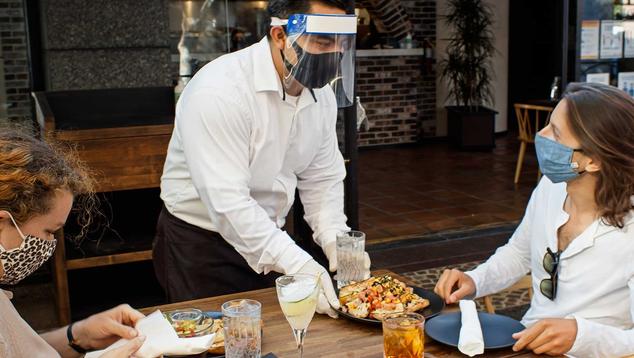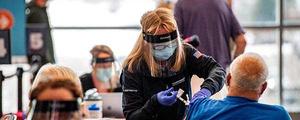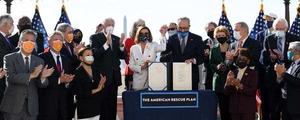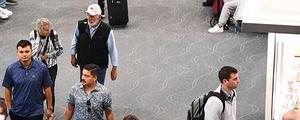Story Highlights
- 38% completely or mostly isolating, down from 47% last month
- Increase in percentage vaccinated largely explains decline in isolating
- Avoidance of public places down from 56% to 48%
WASHINGTON, D.C. -- Americans' self-reported strict social distancing has declined nine percentage points in the past month. Currently, 38% say they are completely or mostly isolating themselves from people outside their household, which ties for the low in Gallup's trend, measured in November.

Line graph. Thirty-eight percent of Americans say they are completely or mostly isolating themselves from people outside their household, tied with the November low point in Gallup's trend. In March, April and May 2020, consistent majorities were isolating themselves, including a high of 75% in late March and early April. By late May, the percentage fell below 50% and stayed mostly around 40% through the summer and fall. It did tick up to 50% in both December and January.
Previously, Gallup found that Americans who received all required doses of a COVID-19 vaccine were much less likely than those who were partially vaccinated, or who planned to get vaccinated, to say they were isolating themselves from others.
That continues to be the case, as 34% of fully vaccinated adults are completely or mostly isolating, compared with 47% of partially vaccinated adults and 46% of those who are not yet vaccinated but plan to be. Adults who do not plan to get vaccinated remain the least likely to socially isolate, with 23% doing so.
The decline in strict social distancing this past month, then, appears to be driven mostly by the increase in U.S. vaccination rates. Thirty-two percent of U.S. adults reported having received at least one dose of a COVID-19 vaccine at the time of the March 15-21 survey, compared with 15% who were fully or partially vaccinated in February and 9% in January.
While increased vaccination explains much of the decline in strict social distancing practices, all vaccination status groups show at least modest declines. This includes a steeper 12-point drop among Americans who plan to get vaccinated but have not yet received any doses. The yet-to-be vaccinated group remains the largest segment of the U.S. population, at 42%, although it has shrunk from an average of 59% in January and February.
| Jan-Feb 2021 | Mar 2021 | Change | ||||||||||||||||||||||||||||||||||||||||||||||||||||||||||||||||||||||||||||||||||||||||||||||||||
|---|---|---|---|---|---|---|---|---|---|---|---|---|---|---|---|---|---|---|---|---|---|---|---|---|---|---|---|---|---|---|---|---|---|---|---|---|---|---|---|---|---|---|---|---|---|---|---|---|---|---|---|---|---|---|---|---|---|---|---|---|---|---|---|---|---|---|---|---|---|---|---|---|---|---|---|---|---|---|---|---|---|---|---|---|---|---|---|---|---|---|---|---|---|---|---|---|---|---|---|---|
| % | % | pct. pts. | ||||||||||||||||||||||||||||||||||||||||||||||||||||||||||||||||||||||||||||||||||||||||||||||||||
| Completely/Mostly isolating | ||||||||||||||||||||||||||||||||||||||||||||||||||||||||||||||||||||||||||||||||||||||||||||||||||||
| Fully vaccinated | 38 | 34 | -4 | |||||||||||||||||||||||||||||||||||||||||||||||||||||||||||||||||||||||||||||||||||||||||||||||||
| Partially vaccinated | 51 | 47 | -4 | |||||||||||||||||||||||||||||||||||||||||||||||||||||||||||||||||||||||||||||||||||||||||||||||||
| Plan to get vaccinated | 58 | 46 | -12 | |||||||||||||||||||||||||||||||||||||||||||||||||||||||||||||||||||||||||||||||||||||||||||||||||
| Do not plan to get vaccinated | 28 | 23 | -5 | |||||||||||||||||||||||||||||||||||||||||||||||||||||||||||||||||||||||||||||||||||||||||||||||||
| Share of U.S. population | ||||||||||||||||||||||||||||||||||||||||||||||||||||||||||||||||||||||||||||||||||||||||||||||||||||
| Fully vaccinated | 5 | 19 | +14 | |||||||||||||||||||||||||||||||||||||||||||||||||||||||||||||||||||||||||||||||||||||||||||||||||
| Partially vaccinated | 8 | 13 | +5 | |||||||||||||||||||||||||||||||||||||||||||||||||||||||||||||||||||||||||||||||||||||||||||||||||
| Plan to get vaccinated | 59 | 42 | -17 | |||||||||||||||||||||||||||||||||||||||||||||||||||||||||||||||||||||||||||||||||||||||||||||||||
| Do not plan to get vaccinated | 29 | 26 | -3 | |||||||||||||||||||||||||||||||||||||||||||||||||||||||||||||||||||||||||||||||||||||||||||||||||
| Gallup Panel | ||||||||||||||||||||||||||||||||||||||||||||||||||||||||||||||||||||||||||||||||||||||||||||||||||||
Fewer Americans Avoiding Public Places
In the past month, there have been eight- or nine-point drops in the percentages of Americans who say they are avoiding public places like stores or restaurants (48%), small gatherings of people (45%), events with large crowds (62%) and travel (57%).
Compared with a year ago, when almost every state had issued stay-at-home orders, the percentages avoiding these places are down roughly 30 percentage points, and are the lowest Gallup has measured since March 13-15, 2020, before many states issued those "lockdown" orders.

Line graph. Americans' avoidance of public places, small gatherings, events with large crowds and traveling by airplane or train has fallen off in the past month, and remains well below where it was in late March and early April 2020. The current figures remain at least slightly higher than where they were one year ago.
Vaccination status does not make much difference in Americans' reports of avoiding outside-the-home activities, except among those who do not plan to get vaccinated. Fully vaccinated adults are nearly as likely as those who are partially vaccinated or who plan to get vaccinated to say they are avoiding large crowds, and they are only slightly less likely to be avoiding public places, small social gatherings and travel. As a result, the declines seen in these activities among all Americans in the past month are less tied to increases in vaccinations, and more a function of changes in behavior regardless of vaccination status.
% Have done in the past seven days
| Fully vaccinated | Partially vaccinated | Plan to get vaccinated | Do not plan to get vaccinated | ||||||||||||||||||||||||||||||||||||||||||||||||||||||||||||||||||||||||||||||||||||||||||||||||
|---|---|---|---|---|---|---|---|---|---|---|---|---|---|---|---|---|---|---|---|---|---|---|---|---|---|---|---|---|---|---|---|---|---|---|---|---|---|---|---|---|---|---|---|---|---|---|---|---|---|---|---|---|---|---|---|---|---|---|---|---|---|---|---|---|---|---|---|---|---|---|---|---|---|---|---|---|---|---|---|---|---|---|---|---|---|---|---|---|---|---|---|---|---|---|---|---|---|---|---|
| % | % | % | % | ||||||||||||||||||||||||||||||||||||||||||||||||||||||||||||||||||||||||||||||||||||||||||||||||
| Avoided going to public places | 54 | 59 | 59 | 22 | |||||||||||||||||||||||||||||||||||||||||||||||||||||||||||||||||||||||||||||||||||||||||||||||
| Avoided small gatherings of people | 48 | 56 | 54 | 22 | |||||||||||||||||||||||||||||||||||||||||||||||||||||||||||||||||||||||||||||||||||||||||||||||
| Avoided going to events with large crowds | 70 | 72 | 73 | 35 | |||||||||||||||||||||||||||||||||||||||||||||||||||||||||||||||||||||||||||||||||||||||||||||||
| Avoided traveling | 63 | 66 | 67 | 31 | |||||||||||||||||||||||||||||||||||||||||||||||||||||||||||||||||||||||||||||||||||||||||||||||
| Gallup Panel, March 15-21, 2021 | |||||||||||||||||||||||||||||||||||||||||||||||||||||||||||||||||||||||||||||||||||||||||||||||||||
Americans' reports of recent visits to specific types of businesses or other public places have also increased as more Americans have been vaccinated. Compared with January and February, there have been at least nominal increases in reports of visiting 10 of 12 types of establishments that Gallup measures, with changes of two percentage points or greater representing a statistically meaningful change.
% Have visited in the past 24 hours
| Jan-Feb 2021 | Mar 2021 | Change | |||||||||||||||||||||||||||||||||||||||||||||||||||||||||||||||||||||||||||||||||||||||||||||||||
|---|---|---|---|---|---|---|---|---|---|---|---|---|---|---|---|---|---|---|---|---|---|---|---|---|---|---|---|---|---|---|---|---|---|---|---|---|---|---|---|---|---|---|---|---|---|---|---|---|---|---|---|---|---|---|---|---|---|---|---|---|---|---|---|---|---|---|---|---|---|---|---|---|---|---|---|---|---|---|---|---|---|---|---|---|---|---|---|---|---|---|---|---|---|---|---|---|---|---|---|
| % | % | pct. pts. | |||||||||||||||||||||||||||||||||||||||||||||||||||||||||||||||||||||||||||||||||||||||||||||||||
| Your place of work* | 52 | 59 | +7 | ||||||||||||||||||||||||||||||||||||||||||||||||||||||||||||||||||||||||||||||||||||||||||||||||
| Grocery store | 49 | 54 | +5 | ||||||||||||||||||||||||||||||||||||||||||||||||||||||||||||||||||||||||||||||||||||||||||||||||
| Restaurant | 23 | 27 | +4 | ||||||||||||||||||||||||||||||||||||||||||||||||||||||||||||||||||||||||||||||||||||||||||||||||
| Someone else's home or apartment | 20 | 24 | +4 | ||||||||||||||||||||||||||||||||||||||||||||||||||||||||||||||||||||||||||||||||||||||||||||||||
| Pharmacy | 16 | 19 | +3 | ||||||||||||||||||||||||||||||||||||||||||||||||||||||||||||||||||||||||||||||||||||||||||||||||
| Other store | 23 | 26 | +3 | ||||||||||||||||||||||||||||||||||||||||||||||||||||||||||||||||||||||||||||||||||||||||||||||||
| Doctor's office, hospital or treatment center | 12 | 14 | +2 | ||||||||||||||||||||||||||||||||||||||||||||||||||||||||||||||||||||||||||||||||||||||||||||||||
| Salon or barbershop | 5 | 6 | +1 | ||||||||||||||||||||||||||||||||||||||||||||||||||||||||||||||||||||||||||||||||||||||||||||||||
| Gym | 5 | 6 | +1 | ||||||||||||||||||||||||||||||||||||||||||||||||||||||||||||||||||||||||||||||||||||||||||||||||
| Travel (by airplane, boat, etc.) | 2 | 3 | +1 | ||||||||||||||||||||||||||||||||||||||||||||||||||||||||||||||||||||||||||||||||||||||||||||||||
| Place of worship (church, temple, synagogue, etc.) | 9 | 9 | 0 | ||||||||||||||||||||||||||||||||||||||||||||||||||||||||||||||||||||||||||||||||||||||||||||||||
| Public transportation (bus, train, etc.) | 2 | 2 | 0 | ||||||||||||||||||||||||||||||||||||||||||||||||||||||||||||||||||||||||||||||||||||||||||||||||
| *Results for "place of work" item based on employed adults | |||||||||||||||||||||||||||||||||||||||||||||||||||||||||||||||||||||||||||||||||||||||||||||||||||
| Gallup Panel | |||||||||||||||||||||||||||||||||||||||||||||||||||||||||||||||||||||||||||||||||||||||||||||||||||
Reports of visiting workplaces, grocery stores and gyms are at their highest points during the pandemic. Most other items are a percentage point or two shy of their high points.
Americans who have been fully vaccinated tend to be slightly more likely than those who are partially vaccinated or who plan to get vaccinated to say they have been to the more commonly visited places. However, people who do not plan to get vaccinated are still the most likely to say they have visited nearly all of these places.
| Fully vaccinated | Partially vaccinated | Plan to get vaccinated | Do not plan to get vaccinated | ||||||||||||||||||||||||||||||||||||||||||||||||||||||||||||||||||||||||||||||||||||||||||||||||
|---|---|---|---|---|---|---|---|---|---|---|---|---|---|---|---|---|---|---|---|---|---|---|---|---|---|---|---|---|---|---|---|---|---|---|---|---|---|---|---|---|---|---|---|---|---|---|---|---|---|---|---|---|---|---|---|---|---|---|---|---|---|---|---|---|---|---|---|---|---|---|---|---|---|---|---|---|---|---|---|---|---|---|---|---|---|---|---|---|---|---|---|---|---|---|---|---|---|---|---|
| % | % | % | % | ||||||||||||||||||||||||||||||||||||||||||||||||||||||||||||||||||||||||||||||||||||||||||||||||
| Your place of work* | 65 | 49 | 52 | 71 | |||||||||||||||||||||||||||||||||||||||||||||||||||||||||||||||||||||||||||||||||||||||||||||||
| Grocery store | 52 | 47 | 51 | 64 | |||||||||||||||||||||||||||||||||||||||||||||||||||||||||||||||||||||||||||||||||||||||||||||||
| Restaurant | 25 | 20 | 20 | 41 | |||||||||||||||||||||||||||||||||||||||||||||||||||||||||||||||||||||||||||||||||||||||||||||||
| Someone else's home or apartment | 23 | 13 | 20 | 37 | |||||||||||||||||||||||||||||||||||||||||||||||||||||||||||||||||||||||||||||||||||||||||||||||
| Pharmacy | 20 | 18 | 16 | 21 | |||||||||||||||||||||||||||||||||||||||||||||||||||||||||||||||||||||||||||||||||||||||||||||||
| Other store | 25 | 25 | 22 | 34 | |||||||||||||||||||||||||||||||||||||||||||||||||||||||||||||||||||||||||||||||||||||||||||||||
| Doctor's office, hospital or treatment center | 17 | 17 | 12 | 14 | |||||||||||||||||||||||||||||||||||||||||||||||||||||||||||||||||||||||||||||||||||||||||||||||
| *Results for "place of work" item based on employed adults Data not shown for less frequently visited places (place of worship, gym, salon or barbershop, public transportation, travel) |
|||||||||||||||||||||||||||||||||||||||||||||||||||||||||||||||||||||||||||||||||||||||||||||||||||
| Gallup Panel, March 15-21, 2021 | |||||||||||||||||||||||||||||||||||||||||||||||||||||||||||||||||||||||||||||||||||||||||||||||||||
Fully vaccinated Americans also tend to show a greater increase in visits to these places in the past month than those who are partially vaccinated or plan to get vaccinated. For example, visits to restaurants are up seven percentage points among those who have been fully vaccinated, compared with no increase among those partially vaccinated and a four-point increase among those who plan to get vaccinated.
Bottom Line
Fewer Americans than a month ago are practicing social distancing measures to protect themselves from the coronavirus, and the percentages doing so are at, or approaching, their low points in the pandemic. Many of these changes can be tied to the increasing number of Americans who have been fully vaccinated from COVID-19. Those who are fully vaccinated are less likely to practice coronavirus mitigation methods than those who have not yet been fully vaccinated but plan to be.
Still, some of the changes in avoidance behaviors are being seen among the not-yet-fully vaccinated population, which may put them at risk for catching the coronavirus before they can receive the benefits of vaccination. Indeed, many states are reporting increases in infections and hospitalizations in recent days. While social distancing practices are declining, mask usage outside the home remains common, including among those who are fully vaccinated.
The pace of vaccinations is picking up, however -- and every day, millions more Americans gain protection from the worst effects of the coronavirus. As such, in each coming month, social distancing activities will likely continue to decline.
Learn more about how the Gallup Panel works.




